
|
It brightened very rapidly. Now it is 11.8 mag (June 7, Osamu Miyazaki). It will fade out rapidly after this. In the Northern Hemisphere, it stays observable in good condition. In the Southern Hemisphere, it is not observable now, but it will appear in August.
Date(TT) R.A. (2000) Decl. Delta r Elong. m1 Best Time(A, h)
June 10 12 38.13 72 21.2 0.737 1.084 74 10.1 20:58 (169, 51)
June 17 13 1.57 74 55.9 0.714 1.053 72 9.7 21:03 (170, 48)
|

|
Now it is 10.6 mag (Apr. 9, Ken-ichi Kadota). It stays 10 mag for a while. It will be getting higher gradually.
Date(TT) R.A. (2000) Decl. Delta r Elong. m1 Best Time(A, h)
June 10 3 0.45 19 25.3 3.075 2.259 30 10.0 3:00 (247, 1)
June 17 3 3.99 18 3.9 3.007 2.274 36 10.0 2:58 (251, 5)
|

|
It brightened up to 8 mag from 2022 summer to 2023 spring. Now it is 10.7 mag (May 30, Thomas Lehmann). Fading slowly. In the Northern Hemisphere, it is not observable now, but it will appear in August. It locates somewhat low in the Southern Hemisphere. But it will become high in summer.
Date(TT) R.A. (2000) Decl. Delta r Elong. m1 Best Time(A, h)
June 10 5 36.49 -14 42.6 3.499 2.773 38 10.0 20:58 (101,-40)
June 17 5 44.70 -13 30.5 3.580 2.834 36 10.2 21:03 (106,-44)
|
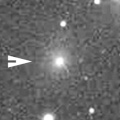
|
It is expected to brighten up to 8 mag in July. Now it is 10.6 mag (June 1, Thomas Lehmann). It will turn to fade out rapidly after brightening. It stays extremely low in the Northern Hemisphere. But it will become high in winter. In the Southern Hemisphere, it stays observable in good condition. At the high light, it will be observable in excellent condition in the Southern Hemisphere, but it will be very low in the Northern Hemisphere.
Date(TT) R.A. (2000) Decl. Delta r Elong. m1 Best Time(A, h)
June 10 0 40.37 -16 8.4 1.555 1.649 76 10.6 3:00 (296, 8)
June 17 0 35.29 -18 45.3 1.335 1.609 85 10.2 2:58 (303, 12)
|

|
Now it is 12.1 mag (May 24, Osamu Miyazaki). It stays 13 mag for a while. It will be unobservable in July in the Northern Hemisphere, or in August in the Southern Hemisphere. But it will be observable again in September in the Southern Hemisphere.
Date(TT) R.A. (2000) Decl. Delta r Elong. m1 Best Time(A, h)
June 10 10 23.56 -5 34.4 3.693 3.682 81 12.1 20:58 ( 65, 23)
June 17 10 21.71 -6 10.2 3.826 3.694 74 12.2 21:03 ( 70, 16)
|
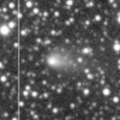
|
It brightened very rapidly as expected. Now it is 12.5 mag (May 31, Osamu Miyazaki). It will fade out rapidly after this. It stays observable in good condition.
Date(TT) R.A. (2000) Decl. Delta r Elong. m1 Best Time(A, h)
June 10 20 0.98 -5 43.1 1.144 1.998 135 12.3 2:50 ( 0, 49)
June 17 20 0.07 -4 11.8 1.111 2.005 141 12.3 2:22 ( 0, 51)
|

|
Now it is 12.2 mag (May 30, Taras Prystavski). Fading slowly. In the Northern Hemisphere, it is not observable now. In the Southern Hemisphere, it stays observable in good condition. It was expected to brighten up to 10 mag from spring to summer. However, it is fainter than originally expected.
Date(TT) R.A. (2000) Decl. Delta r Elong. m1 Best Time(A, h)
June 10 21 10.20 -77 45.2 2.472 3.089 118 12.3 3:00 (356,-23)
June 17 21 5.74 -81 30.4 2.481 3.097 118 12.4 2:58 (359,-26)
|
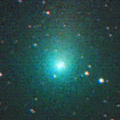
|
It brightened up to 9.5 mag from winter to early spring (Jan. 30, Katsumi Yoshimoto). Now it is 11.4 mag (May 31, Ken-ichi Kadota). Fading gradually. In the Northern Hemisphere, it stays observable in good condition. It locates somewhat low in the Southern Hemisphere. But it will become high in summer.
Date(TT) R.A. (2000) Decl. Delta r Elong. m1 Best Time(A, h)
June 10 0 58.45 35 56.1 2.659 2.244 55 12.4 3:00 (246, 33)
June 17 0 59.78 35 15.9 2.615 2.299 60 12.6 2:58 (249, 37)
|

|
It is expected to brighten up to 11 mag in July. Now it is 14.8 mag (May 30, Thomas Lehmann). It will turn to fade out rapidly after brightening. It stays extremely low. But it will become high in autumn in the Northern Hemisphere, or in autumn in the Northern Hemisphere. Recently it is much fainter than this ephemeris.
Date(TT) R.A. (2000) Decl. Delta r Elong. m1 Best Time(A, h)
June 10 2 3.84 19 20.5 1.519 1.048 43 13.0 3:00 (255, 12)
June 17 2 39.32 20 52.2 1.506 1.006 41 12.6 2:58 (252, 11)
|

|
Now it is 13.1 mag (May 30, Thomas Lehmann). It will fade out rapidly after this. It stays observable in good condition.
Date(TT) R.A. (2000) Decl. Delta r Elong. m1 Best Time(A, h)
June 10 17 21.09 -18 17.3 1.274 2.286 174 13.2 0:11 ( 0, 37)
June 17 17 14.32 -18 21.7 1.317 2.327 172 13.4 23:32 ( 0, 37)
|

|
It brightened up to 8.3 mag in 2021-2022 winter (Jan. 6, 2022, Toshiyuki Takahashi). Now it is 12.7 mag (May 23, Chris Wyatt). Fading slowly. In the Northern Hemisphere, it is not observable now. In the Southern Hemisphere, it will be getting lower gradually. But it will be getting higher again after September.
Date(TT) R.A. (2000) Decl. Delta r Elong. m1 Best Time(A, h)
June 10 9 20.63 -30 3.0 5.803 5.717 80 13.4 20:58 ( 56, -5)
June 17 9 25.05 -29 59.8 5.921 5.761 76 13.5 21:03 ( 60, -9)
|

|
It approached to Earth down to 0.29 a.u. in early February, and it brightened up to 4.5 mag (Feb. 1, Juan Jose Gonzalez). Now it is 12.5 mag (May 30, Thomas Lehmann). Fading gradually. In the Northern Hemisphere, it is not observable now, but it will appear in September. In the Southern Hemisphere, it will be getting higher gradually.
Date(TT) R.A. (2000) Decl. Delta r Elong. m1 Best Time(A, h)
June 10 5 47.89 -17 2.8 3.124 2.451 41 13.4 20:58 ( 96,-39)
June 17 5 53.70 -18 14.8 3.197 2.531 41 13.6 21:03 ( 99,-45)
|
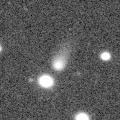
|
It is expected to brighten up to 7 mag in early 2024. Now it is 14.3 mag (June 4, ATLAS Chile). Brightening gradually. In the Northern Hemisphere, it is not observable now. It locates somewhat low in the Southern Hemisphere. But it will become high in winter.
Date(TT) R.A. (2000) Decl. Delta r Elong. m1 Best Time(A, h)
June 10 6 29.82 -23 41.3 4.071 3.514 50 13.5 20:58 ( 83,-34)
June 17 6 39.62 -23 31.1 4.020 3.442 49 13.4 21:03 ( 86,-38)
|
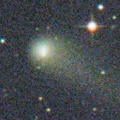
|
It brightened up to 11.1 mag in early 2022 (Mar. 31, 2022, F. Kugel, J.-G. Bosch, J. Nicolas). Now it is 12.8 mag (June 7, Osamu Miyazaki). Fading slowly. It stays observable in good condition.
Date(TT) R.A. (2000) Decl. Delta r Elong. m1 Best Time(A, h)
June 10 15 17.30 21 38.5 4.509 5.191 127 13.6 22:03 ( 0, 77)
June 17 15 15.22 21 48.4 4.602 5.223 122 13.7 21:34 ( 0, 77)
|

|
It approached to Earth down to 0.12 a.u. in April, and brightened up to 11.5 mag (Apr. 8, Osamu Miyazaki). Now it is 12.7 mag (May 31, Thomas Lehmann). Fading rapidly. It will be fainter than 18 mag in July. In the Northern Hemisphere, it will be getting higher gradually. In the Southern Hemisphere, it stays observable in good condition.
Date(TT) R.A. (2000) Decl. Delta r Elong. m1 Best Time(A, h)
June 10 1 34.27 -5 45.0 0.745 0.911 60 13.9 3:00 (280, 4)
June 17 1 47.75 -4 32.3 0.804 0.967 62 14.7 2:58 (281, 7)
|

|
The brightness evolution is slower than originally predicted. Now it is 13.6 mag (May 30, Thomas Lehmann). Fading slowly. In the Northern Hemisphere, it is not observable now. It locates somewhat low in the Southern Hemisphere. But it will become high in winter.
Date(TT) R.A. (2000) Decl. Delta r Elong. m1 Best Time(A, h)
June 10 6 15.15 -32 38.6 2.448 2.090 57 14.0 20:58 ( 74,-40)
June 17 6 35.13 -34 22.9 2.441 2.111 59 14.1 21:03 ( 73,-43)
|

|
Now it is 14.6 mag (May 9, Ken-ichi Kadota). It stays 14 mag for a while. It will be unobservable in August. But it will be observable again in August.
Date(TT) R.A. (2000) Decl. Delta r Elong. m1 Best Time(A, h)
June 10 7 5.05 25 54.6 7.001 6.107 26 14.1 20:58 (120, 2)
June 17 7 10.64 25 41.0 7.047 6.109 20 14.1 21:03 (124, -2)
|

|
It will brighten rapidly up to 13.5 mag in summer. Now it is 15 mag (May 19, Giuseppe Pappa). It stays 14 mag for a while. In the Northern Hemisphere, it will be getting higher gradually. In the Southern Hemisphere, it will be getting lower gradually after this, and it will be unobservable in September.
Date(TT) R.A. (2000) Decl. Delta r Elong. m1 Best Time(A, h)
June 10 1 20.16 -3 38.3 1.959 1.733 62 14.2 3:00 (280, 8)
June 17 1 30.43 -0 14.8 1.889 1.722 64 14.1 2:58 (280, 13)
|
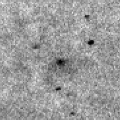
|
Now it is 13.8 mag (May 31, Thomas Lehmann). Fading gradually. In the Northern Hemisphere, it will be getting higher gradually. In the Southern Hemisphere, it stays observable in good condition.
Date(TT) R.A. (2000) Decl. Delta r Elong. m1 Best Time(A, h)
June 10 0 40.48 -5 25.0 2.104 2.028 71 14.3 3:00 (288, 15)
June 17 0 50.65 -4 36.2 2.067 2.065 75 14.4 2:58 (290, 19)
|
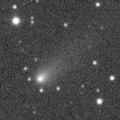
|
Now it is 14.4 mag (May 31, Ken-ichi Kadota). Fading gradually. In the Northern Hemisphere, it will be unobservable in August. In the Southern Hemisphere, it stays observable in good condition.
Date(TT) R.A. (2000) Decl. Delta r Elong. m1 Best Time(A, h)
June 10 13 22.14 -32 31.8 1.617 2.391 129 14.5 20:58 ( 11, 21)
June 17 13 22.36 -32 44.0 1.687 2.401 123 14.6 21:03 ( 18, 20)
|
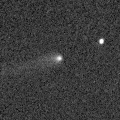
|
Now it is 14.9 mag (Mar. 19, Masayoshi Yoshimi). It stays 14 mag for a while. In the Northern Hemisphere, it is not observable now, but it will be observable soon. In the Southern Hemisphere, it will be getting higher gradually.
Date(TT) R.A. (2000) Decl. Delta r Elong. m1 Best Time(A, h)
June 10 2 43.39 3 49.8 3.943 3.236 40 14.6 3:00 (262, -5)
June 17 2 43.34 4 26.1 3.855 3.240 46 14.5 2:58 (265, 1)
|

|
It will brighten up to 13 mag in summer. Now it is 14.7 mag (May 28, Thomas Lehmann). It will turn to fade out rapidly after brightening. In the Northern Hemisphere, it stays observable in good condition. In the Southern Hemisphere, it is not observable now, but it will appear in August.
Date(TT) R.A. (2000) Decl. Delta r Elong. m1 Best Time(A, h)
June 10 1 39.92 64 5.0 1.754 1.410 53 14.7 3:00 (211, 34)
June 17 1 27.28 64 37.7 1.652 1.400 57 14.6 2:58 (211, 38)
|

|
Now it is 16.2 mag (May 30, Taras Prystavski). It stays 15 mag for a while. It locates somewhat low in the Northern Hemisphere. In the Southern Hemisphere, it stays observable in good condition. It is fainter than this ephemeris recently.
Date(TT) R.A. (2000) Decl. Delta r Elong. m1 Best Time(A, h)
June 10 18 26.56 -21 46.8 1.957 2.940 162 14.7 1:17 ( 0, 33)
June 17 18 22.05 -22 52.7 1.928 2.934 170 14.6 0:45 ( 0, 32)
|
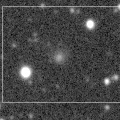
|
Now it is 15.2 mag (May 24, Ken-ichi Kadota). It stays 15 mag for a while. It stays observable in good condition. It is expected to brighten up to 12.5 mag in 2024 spring. At the high light, it will be observable in excellent condition in the Southern Hemisphere, but it will be low in the Northern Hemisphere.
Date(TT) R.A. (2000) Decl. Delta r Elong. m1 Best Time(A, h)
June 10 17 3.38 22 42.5 3.101 3.879 134 14.9 23:48 ( 0, 78)
June 17 16 48.99 22 8.1 3.067 3.831 132 14.8 23:06 ( 0, 77)
|
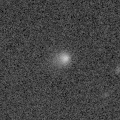
|
Now it is 14.9 mag (June 6, ATLAS Chile). It stays 15 mag for a while. It will be unobservable soon in the Northern Hemisphere, or in August in the Southern Hemisphere. But it will be observable again in September. It is expected to brighten up to 12 mag from 2024 to 2025.
Date(TT) R.A. (2000) Decl. Delta r Elong. m1 Best Time(A, h)
June 10 8 56.36 -0 20.3 5.859 5.417 59 15.2 20:58 ( 83, 9)
June 17 8 57.78 0 15.7 5.919 5.375 53 15.2 21:03 ( 88, 3)
|

|
It will brighten up to 14 mag from 2024 to 2025. Now it is 15.3 mag (June 1, ATLAS Chile). It stays 15 mag for a while. In the Northern Hemisphere, it is not observable now. In the Southern Hemisphere, it will be getting lower gradually. But it will be getting higher again after September.
Date(TT) R.A. (2000) Decl. Delta r Elong. m1 Best Time(A, h)
June 10 9 10.50 -28 23.3 6.207 6.066 77 15.3 20:58 ( 59, -5)
June 17 9 15.67 -27 57.2 6.253 6.037 73 15.3 21:03 ( 62,-10)
|

|
Now it is 15.9 mag (May 25, Thomas Lehmann). It stays 15 mag for a while. In the Northern Hemisphere, it will be getting higher gradually. In the Southern Hemisphere, it stays observable in good condition.
Date(TT) R.A. (2000) Decl. Delta r Elong. m1 Best Time(A, h)
June 10 0 24.62 -6 6.0 3.548 3.437 75 15.4 3:00 (291, 18)
June 17 0 30.10 -5 41.6 3.467 3.452 80 15.4 2:58 (294, 22)
|
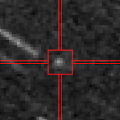
|
It is expected to brighten up to 7.5 mag in October, and it will be observable in excellent condition. Now it is 15.8 mag (June 1, Thomas Lehmann). Brightening rapidly. In the Northern Hemisphere, it stays observable in good condition. In the Southern Hemisphere, it will be getting lower gradually. But it will be getting higher again after September. In the Southern Hemisphere, it becomes low temporarily around the high light.
Date(TT) R.A. (2000) Decl. Delta r Elong. m1 Best Time(A, h)
June 10 22 20.49 8 41.5 1.461 1.890 97 15.8 3:00 (304, 50)
June 17 22 32.23 10 56.7 1.344 1.828 100 15.4 2:58 (305, 54)
|
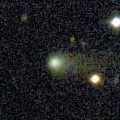
|
Now it is 15.8 mag (May 23, Toshihiko Ikemura, Hirohisa Sato). It stays 16 mag for a while. It will be unobservable in August in the Southern Hemisphere, or in September in the Northern Hemisphere.
Date(TT) R.A. (2000) Decl. Delta r Elong. m1 Best Time(A, h)
June 10 10 18.37 25 34.9 3.784 3.553 69 15.6 20:58 ( 96, 39)
June 17 10 26.55 24 51.3 3.888 3.574 64 15.7 21:03 ( 98, 34)
|

|
It brightened up to 13.4 mag in last summer (July 7, Giuseppe Pappa). Now it is 15.6 mag (May 31, Ken-ichi Kadota). Fading slowly. In the Northern Hemisphere, it stays observable in good condition. In the Southern Hemisphere, it will be unobservable in October.
Date(TT) R.A. (2000) Decl. Delta r Elong. m1 Best Time(A, h)
June 10 16 26.00 32 44.2 3.283 3.934 123 15.8 23:11 ( 0, 88)
June 17 16 14.36 33 28.5 3.374 3.977 119 15.9 22:32 ( 0, 88)
|

|
Now it is 17.3 mag (May 18, Hidetaka Sato). It will fade out rapidly after this. It will be fainter than 18 mag in July. In the Northern Hemisphere, it is not observable now, but it will appear in July. In the Southern Hemisphere, it will be unobservable in July. In its last apparition in 2014, it was re-observed after 36-year blank.
Date(TT) R.A. (2000) Decl. Delta r Elong. m1 Best Time(A, h)
June 10 2 58.43 14 21.1 1.429 0.788 32 15.9 3:00 (252, -1)
June 17 3 34.89 18 8.8 1.484 0.781 29 15.9 2:58 (247, -1)
|

|
Rob Matson discovered it as a bright new comet as 11 mag from SWAN images between Apr. 5 and 15. It was revealed to be an asteroid which has been observed also in 2012 and 2018. It approached to Sun down to 0.5 a.u. on Mar. 29. Now it is 16.5 mag (May 13, Hidetaka Sato). Fading rapidly. It will be fainter than 18 mag in July. In the Northern Hemisphere, it is not observable now, but it will be observable soon. In the Southern Hemisphere, it stays observable in good condition.
Date(TT) R.A. (2000) Decl. Delta r Elong. m1 Best Time(A, h)
June 10 15 29.45 -65 29.0 0.494 1.406 134 15.9 22:17 ( 0,-10)
June 17 15 31.20 -56 8.7 0.572 1.498 139 16.5 21:51 ( 0, -1)
|
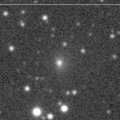
|
Brightened rapidly. It continues brightening even after the perihelion passage. Now it is 14.9 mag (May 16, Toshihiko Ikemura, Hirohisa Sato). It will fade out rapidly after this. It will be fainter than 18 mag in July. It stays observable in good condition.
Date(TT) R.A. (2000) Decl. Delta r Elong. m1 Best Time(A, h)
June 10 13 14.25 -1 28.3 1.411 2.099 118 16.0 20:58 ( 23, 51)
June 17 13 23.14 0 5.4 1.529 2.149 113 16.3 21:03 ( 32, 50)
|
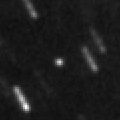
|
It will approach to Sun down to 0.4 a.u. in late September in 2024, and it is expected to brighten up to 0 mag. Now it is 16.4 mag (June 5, Ken-ichi Kadota). It stays 16 mag for a while. It will be getting lower gradually after this, and it will be unobservable in October. At the high light, in the Northern Hemisphere, it will be observable in good condition after the perihelion passage. In the Southern Hemisphere, it will be observable in the low sky before and after the perihelion passage.
Date(TT) R.A. (2000) Decl. Delta r Elong. m1 Best Time(A, h)
June 10 14 22.83 3 19.8 5.621 6.339 131 16.3 21:09 ( 0, 58)
June 17 14 18.62 3 20.1 5.644 6.273 124 16.2 21:03 ( 12, 58)
|
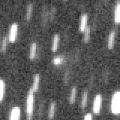
|
It returns for the first time in 70 years. It will brighten up to 4.5 mag in 2024 spring. Now it is 16.9 mag (May 25, Ken-ichi Kadota). Brightening gradually. In the Northern Hemisphere, it stays observable in good condition. In the Southern Hemisphere, it will be unobservable in July.
Date(TT) R.A. (2000) Decl. Delta r Elong. m1 Best Time(A, h)
June 10 19 17.12 51 14.9 3.984 4.291 100 16.5 2:06 (180, 74)
June 17 19 9.45 52 32.2 3.899 4.222 101 16.4 1:31 (180, 72)
|
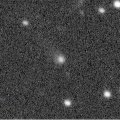
|
Now it is 16.8 mag (June 5, ATLAS Chile). It stays 16 mag for a while. In the Northern Hemisphere, it is not observable now, but it will appear in October. In the Southern Hemisphere, it will be getting lower gradually. But it will be getting higher again after August.
Date(TT) R.A. (2000) Decl. Delta r Elong. m1 Best Time(A, h)
June 10 8 24.58 -11 34.4 4.259 3.832 58 16.5 20:58 ( 79, -4)
June 17 8 27.32 -12 17.1 4.318 3.817 54 16.5 21:03 ( 82,-10)
|

|
Very far object. Now it is 17.0 mag (May 11, ATLAS South Africa). It stays 17 mag for a while. In the Northern Hemisphere, it is not observable now. In the Southern Hemisphere, it stays observable in good condition.
Date(TT) R.A. (2000) Decl. Delta r Elong. m1 Best Time(A, h)
June 10 5 20.32 -67 11.0 10.295 10.348 90 16.8 20:58 ( 25,-48)
June 17 5 24.08 -67 12.2 10.284 10.345 90 16.8 2:58 (334,-48)
|

|
Now it is 17.4 mag (June 5, ATLAS-HKO, Haleakala). It stays 17 mag for a while. In the Northern Hemisphere, it stays observable in good condition. It stays extremely low in the Southern Hemisphere.
Date(TT) R.A. (2000) Decl. Delta r Elong. m1 Best Time(A, h)
June 10 13 9.12 52 14.0 2.800 2.950 88 16.8 20:58 (151, 70)
June 17 13 14.29 50 54.4 2.834 2.938 85 16.8 21:03 (141, 67)
|

|
The ATLAS search program detected its cometary activity in April. Now it is 16.4 mag (May 29, ATLAS South Africa). It stays 17 mag for a while. It locates somewhat low in the Northern Hemisphere. In the Southern Hemisphere, it stays observable in good condition.
Date(TT) R.A. (2000) Decl. Delta r Elong. m1 Best Time(A, h)
June 10 23 25.07 -24 11.4 2.419 2.721 96 16.9 3:00 (315, 15)
June 17 23 33.23 -24 7.8 2.357 2.733 100 16.8 2:58 (318, 18)
|
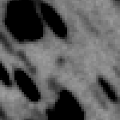
|
Now it is 16.9 mag (May 27, Jost Jahn). It stays 17 mag for a while. It stays observable in good condition.
Date(TT) R.A. (2000) Decl. Delta r Elong. m1 Best Time(A, h)
June 10 18 17.75 -12 26.3 1.855 2.833 160 17.0 1:08 ( 0, 43)
June 17 18 12.71 -11 56.0 1.814 2.811 166 16.9 0:35 ( 0, 43)
|

|
It has not been observed yet in this apparition. It will brighten very rapidly, and it is expected to brighten up to 15 mag in summer. Brightening slowly. It locates somewhat low in the Northern Hemisphere. In the Southern Hemisphere, it stays observable in good condition.
Date(TT) R.A. (2000) Decl. Delta r Elong. m1 Best Time(A, h)
June 10 17 8.21 -37 37.5 1.301 2.298 165 17.2 23:54 ( 0, 17)
June 17 17 1.37 -37 7.9 1.279 2.273 163 16.9 23:20 ( 0, 18)
|

|
Now it is 18 mag (May 11, Giuseppe Pappa). It stays 17 mag for a while. It stays observable in good condition. It is fainter than this ephemeris recently.
Date(TT) R.A. (2000) Decl. Delta r Elong. m1 Best Time(A, h)
June 10 22 55.85 -8 6.9 2.751 3.037 96 17.2 3:00 (310, 32)
June 17 23 0.83 -8 9.4 2.657 3.036 102 17.1 2:58 (315, 35)
|
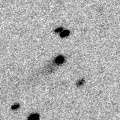
|
Now it is 17.0 mag (May 23, Toshihiko Ikemura, Hirohisa Sato). It stays 17 mag for a while. It will be getting lower gradually after this, and it will be unobservable in September.
Date(TT) R.A. (2000) Decl. Delta r Elong. m1 Best Time(A, h)
June 10 12 21.12 14 26.3 8.790 9.022 100 17.1 20:58 ( 57, 58)
June 17 12 19.14 14 28.2 8.918 9.031 93 17.1 21:03 ( 67, 51)
|

|
Now it is 17.4 mag (May 25, ATLAS-HKO, Haleakala). Fading slowly. It will be fainter than 18 mag in August. It locates somewhat low.
Date(TT) R.A. (2000) Decl. Delta r Elong. m1 Best Time(A, h)
June 10 9 58.43 18 21.1 2.425 2.231 66 17.1 20:58 ( 91, 32)
June 17 10 10.64 17 3.4 2.497 2.235 63 17.2 21:03 ( 92, 27)
|
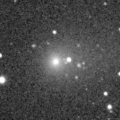
|
It brightened up to 12.4 mag in winter (Feb. 10, Taras Prystavski). Now it is 17.5 mag (May 9, Yukihiro Sugiyama). Fading gradually. It will be fainter than 18 mag in July. It locates somewhat low in the Northern Hemisphere. In the Southern Hemisphere, it will be getting lower gradually.
Date(TT) R.A. (2000) Decl. Delta r Elong. m1 Best Time(A, h)
June 10 10 17.56 16 7.0 2.535 2.421 71 17.1 20:58 ( 86, 35)
June 17 10 28.48 15 12.4 2.645 2.454 68 17.3 21:03 ( 88, 30)
|
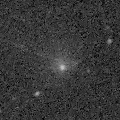
|
Very large comet. It is expected to brighten up to 14 mag in 2031. Now it is 16.1 mag (June 1, Thomas Lehmann). It stays 17 mag for a while. In the Northern Hemisphere, it is not observable now. In the Southern Hemisphere, it stays observable in good condition. In the Northern Hemisphere, it is not observable until 2030.
Date(TT) R.A. (2000) Decl. Delta r Elong. m1 Best Time(A, h)
June 10 3 12.56 -57 54.3 17.644 17.576 84 17.2 3:00 (320,-37)
June 17 3 15.52 -58 8.9 17.578 17.551 86 17.2 2:58 (321,-34)
|

|
It brightened up to 13.6 mag in 2021 (June 17, 2021, R. Carstens). Now it is 17.6 mag (May 13, ATLAS Chile). It stays 18 mag for a while. In the Northern Hemisphere, it will never be observable after this. In the Southern Hemisphere, it stays observable in good condition.
Date(TT) R.A. (2000) Decl. Delta r Elong. m1 Best Time(A, h)
June 10 11 6.12 -66 49.2 6.212 6.638 110 17.2 20:58 ( 17,-18)
June 17 11 2.58 -65 45.1 6.294 6.671 107 17.3 21:03 ( 21,-19)
|

|
It brightened up to 12.7 mag in last year (Feb. 27, 2022, Jose Guilherme de S. Aguiar). Now it is 17.4 mag (June 2, J. L. Virlichie, P. Traverse, H. Roy). Fading gradually. It will be fainter than 18 mag in August. It locates somewhat low in the Northern Hemisphere. In the Southern Hemisphere, it stays observable in good condition.
Date(TT) R.A. (2000) Decl. Delta r Elong. m1 Best Time(A, h)
June 10 20 3.87 -25 29.6 2.184 3.037 140 17.3 2:54 ( 0, 30)
June 17 20 0.09 -25 47.8 2.153 3.062 147 17.3 2:22 ( 0, 29)
|
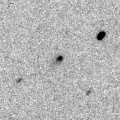
|
Now it is 17.5 mag (June 8, ATLAS-HKO, Haleakala). It stays 18 mag for a while. In the Northern Hemisphere, it will be getting lower gradually. It locates somewhat low in the Southern Hemisphere.
Date(TT) R.A. (2000) Decl. Delta r Elong. m1 Best Time(A, h)
June 10 10 19.15 27 16.2 2.689 2.509 68 17.3 20:58 ( 98, 40)
June 17 10 29.60 25 54.1 2.758 2.506 65 17.4 21:03 ( 99, 35)
|

|
It brightened up to 14.1 mag in 2022 spring (Mar. 22, 2022, Chris Wyatt). It was expected to brighten up to 13 mag. But actually, it was fainter than originally expected. It stays 18 mag for a while. In the Northern Hemisphere, it is not observable now, but it will be observable soon. In the Southern Hemisphere, it will be getting higher gradually.
Date(TT) R.A. (2000) Decl. Delta r Elong. m1 Best Time(A, h)
June 10 2 58.97 -5 31.5 5.266 4.574 42 17.4 3:00 (268,-13)
June 17 3 1.28 -4 58.5 5.239 4.619 47 17.4 2:58 (271, -8)
|

|
It showed cometary activity in 2023, and brightened rapidly. Now it is 17.2 mag (May 27, Jean-Claude Merlin). Fading slowly. It will be fainter than 18 mag in August. It stays extremely low in the Northern Hemisphere. In the Southern Hemisphere, it stays observable in good condition.
Date(TT) R.A. (2000) Decl. Delta r Elong. m1 Best Time(A, h)
June 10 14 16.12 -43 26.8 2.580 3.410 138 17.5 21:03 ( 0, 12)
June 17 14 14.94 -42 33.4 2.632 3.415 133 17.5 21:03 ( 5, 12)
|
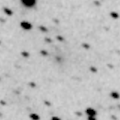
|
Now it is 17.6 mag (May 25, Ken-ichi Kadota). Fading gradually. It will be fainter than 18 mag in July. In the Northern Hemisphere, it stays observable in good condition. It locates somewhat low in the Southern Hemisphere. It looks diffuse, but it has a large coma.
Date(TT) R.A. (2000) Decl. Delta r Elong. m1 Best Time(A, h)
June 10 22 22.48 21 50.7 2.147 2.404 91 17.5 3:00 (286, 58)
June 17 22 24.26 23 49.4 2.119 2.449 96 17.6 2:58 (288, 64)
|

|
First return of a new periodic comet which brightened up to 15 mag in 2008. It has not been recovered yet in this apparition. It stays 18 mag for a while. In the Northern Hemisphere, it will be getting higher gradually. It locates somewhat low in the Southern Hemisphere. But it will become high in autumn.
Date(TT) R.A. (2000) Decl. Delta r Elong. m1 Best Time(A, h)
June 10 1 42.03 20 53.1 2.898 2.345 48 17.7 3:00 (256, 17)
June 17 1 55.64 21 28.4 2.848 2.353 51 17.6 2:58 (257, 20)
|
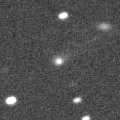
|
It brightened up to 15.9 mag in 2022 spring (May 5, Toshiyuki Takahashi). Now it is 16.8 mag (May 25, Ken-ichi Kadota). It stays 18 mag for a while. It locates somewhat low in the Northern Hemisphere. In the Southern Hemisphere, it stays observable in good condition.
Date(TT) R.A. (2000) Decl. Delta r Elong. m1 Best Time(A, h)
June 10 16 3.66 -24 11.8 3.976 4.963 164 17.6 22:50 ( 0, 31)
June 17 16 0.32 -24 3.9 4.018 4.970 157 17.6 22:19 ( 0, 31)
|

|
Now it is 17.2 mag (May 24, ATLAS-HKO, Haleakala). It stays 18 mag for a while. In the Northern Hemisphere, it stays observable in good condition. In the Southern Hemisphere, it will never be observable after this.
Date(TT) R.A. (2000) Decl. Delta r Elong. m1 Best Time(A, h)
June 10 16 26.92 80 20.0 10.192 10.005 76 17.7 23:08 (180, 45)
June 17 16 6.46 80 17.3 10.228 10.024 75 17.8 22:21 (180, 45)
|

|
It will brighten up to 16 mag in next winter. Now it is 18.2 mag (May 24, Ken-ichi Kadota). It stays 17 mag for a while. In the Northern Hemisphere, it will be getting lower gradually after this, and it will be unobservable in September. But it will be observable again in September. In the Southern Hemisphere, it is not observable now.
Date(TT) R.A. (2000) Decl. Delta r Elong. m1 Best Time(A, h)
June 10 11 42.48 71 53.8 2.794 2.639 70 17.9 20:58 (163, 49)
June 17 11 26.78 68 7.1 2.809 2.592 67 17.9 21:03 (155, 47)
|
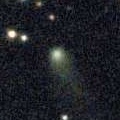
|
Now it is 17.6 mag (June 5, A. Diepvens). It stays 18 mag for a while. In the Northern Hemisphere, it stays observable in good condition. In the Southern Hemisphere, it will never be observable after this.
Date(TT) R.A. (2000) Decl. Delta r Elong. m1 Best Time(A, h)
June 10 18 37.52 64 18.9 6.569 6.666 91 17.9 1:26 (180, 61)
June 17 18 32.23 64 45.9 6.602 6.702 91 17.9 0:53 (180, 60)
|
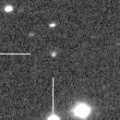
|
It will brighten up to 16 mag in 2024 spring. Now it is 18.3 mag (May 24, ATLAS South Africa). It stays 18 mag for a while. It will be unobservable soon in the Northern Hemisphere, or in August in the Southern Hemisphere. But it will be observable again in October in the Southern Hemisphere.
Date(TT) R.A. (2000) Decl. Delta r Elong. m1 Best Time(A, h)
June 10 9 3.48 -4 41.8 4.499 4.142 63 17.9 20:58 ( 79, 8)
June 17 9 10.23 -4 47.1 4.545 4.108 58 17.9 21:03 ( 82, 3)
|

|
It was predicted to brighten up to 16 mag in 2023. But actually, it is very faint as 18.6 mag (May 3, Taras Prystavski). Fading slowly. In the Northern Hemisphere, it is not observable now. In the Southern Hemisphere, it stays observable in good condition.
Date(TT) R.A. (2000) Decl. Delta r Elong. m1 Best Time(A, h)
June 10 20 39.53 -77 55.9 2.812 3.433 119 18.2 3:00 (358,-23)
June 17 20 21.36 -77 53.9 2.804 3.455 122 18.2 2:46 ( 0,-23)
|
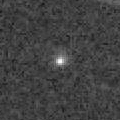
|
It was observed at 17 mag in 2022 autumn. It was predicted to be observable at 17 mag also in 2023 spring. But actually, it is extremely faint as 19.0 mag (May 16, Toshihiko Ikemura, Hirohisa Sato). It will fade out rapidly after this. It stays observable in good condition.
Date(TT) R.A. (2000) Decl. Delta r Elong. m1 Best Time(A, h)
June 10 15 37.00 24 5.6 1.550 2.316 127 20.5 22:21 ( 0, 79)
June 17 15 9.30 22 37.0 1.682 2.375 121 20.8 21:26 ( 0, 77)
|

|
In the last apparition, it had faded before the perihelion passage. It was expected to brighten up to 17 mag if it would become as bright as its last apparition. But actually, it is extremely faint as 22 mag (Apr. 8, Giuseppe Pappa). Fading slowly. It stays observable in good condition.
Date(TT) R.A. (2000) Decl. Delta r Elong. m1 Best Time(A, h)
June 10 13 45.15 6 11.0 1.986 2.667 122 21.8 20:58 ( 14, 60)
June 17 13 46.41 5 28.0 2.050 2.661 116 21.8 21:03 ( 27, 57)
|
|
![]()
 81P/Wild 2
81P/Wild 2 C/2019 L3 ( ATLAS )
C/2019 L3 ( ATLAS ) C/2022 E3 ( ZTF )
C/2022 E3 ( ZTF ) C/2021 S3 ( PanSTARRS )
C/2021 S3 ( PanSTARRS ) C/2019 T4 ( ATLAS )
C/2019 T4 ( ATLAS ) 364P/PanSTARRS
364P/PanSTARRS C/2021 Y1 ( ATLAS )
C/2021 Y1 ( ATLAS ) 29P/Schwassmann-Wachmann 1
29P/Schwassmann-Wachmann 1 126P/IRAS
126P/IRAS 71P/Clark
71P/Clark 77P/Longmore
77P/Longmore C/2021 X1 ( Maury-Attard )
C/2021 X1 ( Maury-Attard ) C/2022 W3 ( Leonard )
C/2022 W3 ( Leonard ) 199P/Shoemaker 4
199P/Shoemaker 4 C/2022 L2 ( ATLAS )
C/2022 L2 ( ATLAS ) C/2022 E2 ( ATLAS )
C/2022 E2 ( ATLAS ) C/2021 G2 ( ATLAS )
C/2021 G2 ( ATLAS ) 117P/Helin-Roman-Alu 1
117P/Helin-Roman-Alu 1 103P/Hartley 2
103P/Hartley 2 C/2020 S4 ( PanSTARRS )
C/2020 S4 ( PanSTARRS ) C/2020 R7 ( ATLAS )
C/2020 R7 ( ATLAS ) 72P/Denning-Fujikawa
72P/Denning-Fujikawa P/2018 HT3 ( NEOWISE )
P/2018 HT3 ( NEOWISE ) C/2023 B2 ( ATLAS )
C/2023 B2 ( ATLAS ) C/2023 A3 ( Tsuchinshan-ATLAS )
C/2023 A3 ( Tsuchinshan-ATLAS ) 12P/Pons-Brooks
12P/Pons-Brooks C/2022 A3 ( Lemmon-ATLAS )
C/2022 A3 ( Lemmon-ATLAS ) C/2019 E3 ( ATLAS )
C/2019 E3 ( ATLAS ) C/2022 U4 ( Bok )
C/2022 U4 ( Bok ) C/2022 JK5 ( PanSTARRS )
C/2022 JK5 ( PanSTARRS ) 219P/LINEAR
219P/LINEAR 213P/Van Ness
213P/Van Ness 287P/Christensen
287P/Christensen C/2020 F2 ( ATLAS )
C/2020 F2 ( ATLAS ) 94P/Russell 4
94P/Russell 4 118P/Shoemaker-Levy 4
118P/Shoemaker-Levy 4 C/2014 UN271 ( Bernardinelli-Bernstein )
C/2014 UN271 ( Bernardinelli-Bernstein ) C/2018 U1 ( Lemmon )
C/2018 U1 ( Lemmon ) 116P/Wild 4
116P/Wild 4 180P/NEAT
180P/NEAT C/2020 Y2 ( ATLAS )
C/2020 Y2 ( ATLAS ) P/2014 OL465 ( PanSTARRS )
P/2014 OL465 ( PanSTARRS ) 80P/Peters-Hartley
80P/Peters-Hartley P/2008 L2 ( Hill )
P/2008 L2 ( Hill ) 99P/Kowal 1
99P/Kowal 1 C/2019 O3 ( Palomar )
C/2019 O3 ( Palomar ) C/2022 V2 ( Lemmon )
C/2022 V2 ( Lemmon ) C/2020 H6 ( ATLAS )
C/2020 H6 ( ATLAS ) C/2022 T1 ( Lemmon )
C/2022 T1 ( Lemmon ) C/2021 C5 ( PanSTARRS )
C/2021 C5 ( PanSTARRS ) C/2022 Q2 ( ATLAS )
C/2022 Q2 ( ATLAS ) 280P/Larsen
280P/Larsen![]()




















































